Not long afterwards, Angus, or "Mac", was joined by Ken Johnstone,
whose engineering background proved invaluable in those early days
of setting up production and distribution. Over the years Ken also
assumed wider production and sales responsibilities.
Many years later Ken would remember:
" The plant in use in those days was certainly very elementary. The pasteuriser
was simply a water jacketed open vessel heated by a large gas ring. I can see
Mac now standing over this piece of equipment with the "agitator," which was
simply a wooden stick, in one hand, and a dairy thermometer in the other.
Churning was carried out in a vertical churn (packed around with ice
and salt), which although power operated was really only a glorified
replica of the type operated by elderly ladies behind the counters
of lollyshops where as a boy I spent my hard earned wealth, a penny
at a time. It was certainly a crude affair when compared with the streamlined
stainless steel continuous freezers in common use today.
After buying our ice for perhaps twelve months, we installed our first
ammonia compressor, a 25 h.p. horizontal Linde, together with a four
ton ice tank. We did not possess a homogeniser in those days, and in
fact it was a good many years later before our first one was installed.
From the churn, the ice cream was transferred to cans which varied
from 11 to 5 gallon capacity. For hardening and holding these were
placed in boxes lined with galvanised iron and packed with ice and
salt. The resultant brine was drained off each night and morning and
the boxes repacked.
For distribution, the cans of ice cream were packed in wooden tubs
with ice and salt. These were also used to serve from at the point
of sale. Owing to rapid melting of the ice, the consistency of the
product varied considerably, and any stocks unsold when the shop closed
had to be dumped. As a five gallon can packed in a tub weighed one
and a quarter hundredweight, a driver in those days certainly needed
to have a strong back."
"We originally started off with one second-hand Model T Ford which Mac brought
with him from Wellington, and as this vehicle was flat-out all day taking care
of both rail orders and the town shops, it was not unusual to have to spend most
of the night carrying out more or less major repairs in order to have the van
on the job again the next morning."
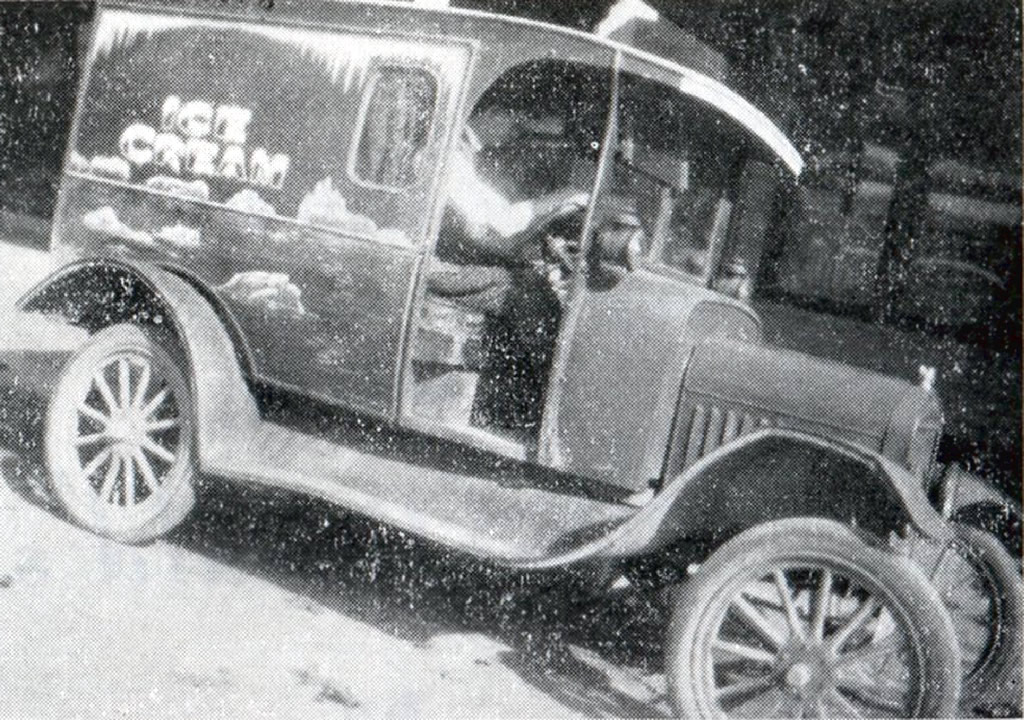
McDonald's first Model T Ford ice cream delivery van, with
Ken Johnstone and Mrs McDonald in the front.
- NZ Ice Cream Assn. archives, Frostee
Digest.
This small newspaper advertisement appeared in the NZ Herald on
Christmas Eve, 1924:

"Ice Cream for Picnics, Parties, Sports, Dances, etc.
- Ring Phone 1724, McDonald's,
Alexandra St., Hamilton." NZ Herald advertisement, 24 December
1924.
-
Papers Past.
They would also travel to where the customers were; to the beach, and
to events as far away as Whangarei, just Mac and Ken in a Model T
van, loaded up with ice cream and blocks of ice.
Their local competitors in those early days were Zero Ice Cream (Grey
St.) and Velvet.
Ken: "The next forward step was to supply each shop with an insulated
cabinet - which incorporated a tub with a tap to draw off the brine.
These cabinets of course still needed repacking daily with ice and
salt, but did, because of the insulation, enable stocks to be held
until sold. Country shops were a bit of a problem as ice had to be
sent by rail at least three times a week to enable the shopkeeper to
repack his cabinet - quite a laborious and messy job which entailed
breaking up the ice by hand."

Kenneth W. Johnstone
Ken Johnstone worked for McDonald's for 35 years.
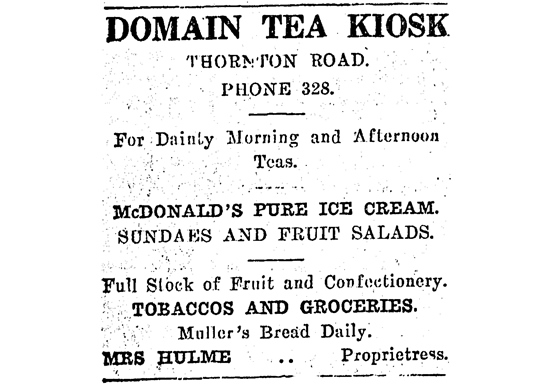
The Domain Tea Kiosk offers McDonald's Pure Ice Cream,
Waikato Independent, 3 December 1925.
- Papers Past.
McDonald Ice Cream Manufacturing Company Limited was registered in
February 1925, with capital of £5000, and with A. K. McDonald
(4000 shares) and E. T. J. Peacocke (1000) as shareholders.
Around 1927 the company purchased 23 Frigidaire electric freezer cabinets,
newly launched on the New Zealand market by John Chambers & Son
Ltd., for supply to it's leading ice cream outlets. These were revolutionary
for the retailers, but created a new problem for the manufacturer,
that of servicing. Refrigeration engineers were not available outside
of Auckland, so Ken added that skill to his repertoire, training under
James McAlpine, who would later establish his own refrigeration business
and and build the first automatic refrigerated ice cream transport
outside of the United States.
In 1928 McDonald's purchased the first Model A Ford commercial vehicle
sold in the Waikato, and in the same year, built their first refrigerated
truck body, mounted on a 30 cwt, 4 cylinder Chevrolet chassis. The
compartment for carrying ice cream was refrigerated by ice and salt,
and there was also a section for crushed ice as they were still packing
some ice cabinets.
On the 30th of April 1927 the Manawatu Times had reported
that "Mr A. K. McDonald, manager of the McDonald Ice Cream Co.,
of Hamilton, is in Palmerston North, negotiating for the opening of
an up-to-date ice-cream factory to supply the wholesale trade next
season". By the end of that year McDonald's was open for business,
operating from a factory in in Main Street West.
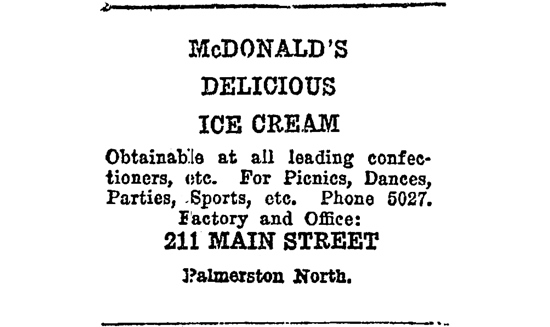
McDonald's Delicious Ice Cream advertisement,
Manawatu Times, 8 December 1927.
- Papers Past.
The company opened branches at Masterton and Hawera, and in November
1928, a new branch and factory in Vivian St., Wellington. McDonald's
advertisements at the time stated: "Mr McDonald is recognised
as the most experienced ice cream maker in the Dominion. His plant
too, is of the very latest type. Ice cream is freshly made in both
factories every day and delivered per motor-vans (properly insulated)
to all parts of the Wellington, Wairarapa, and Manawatu and Oroua
districts."
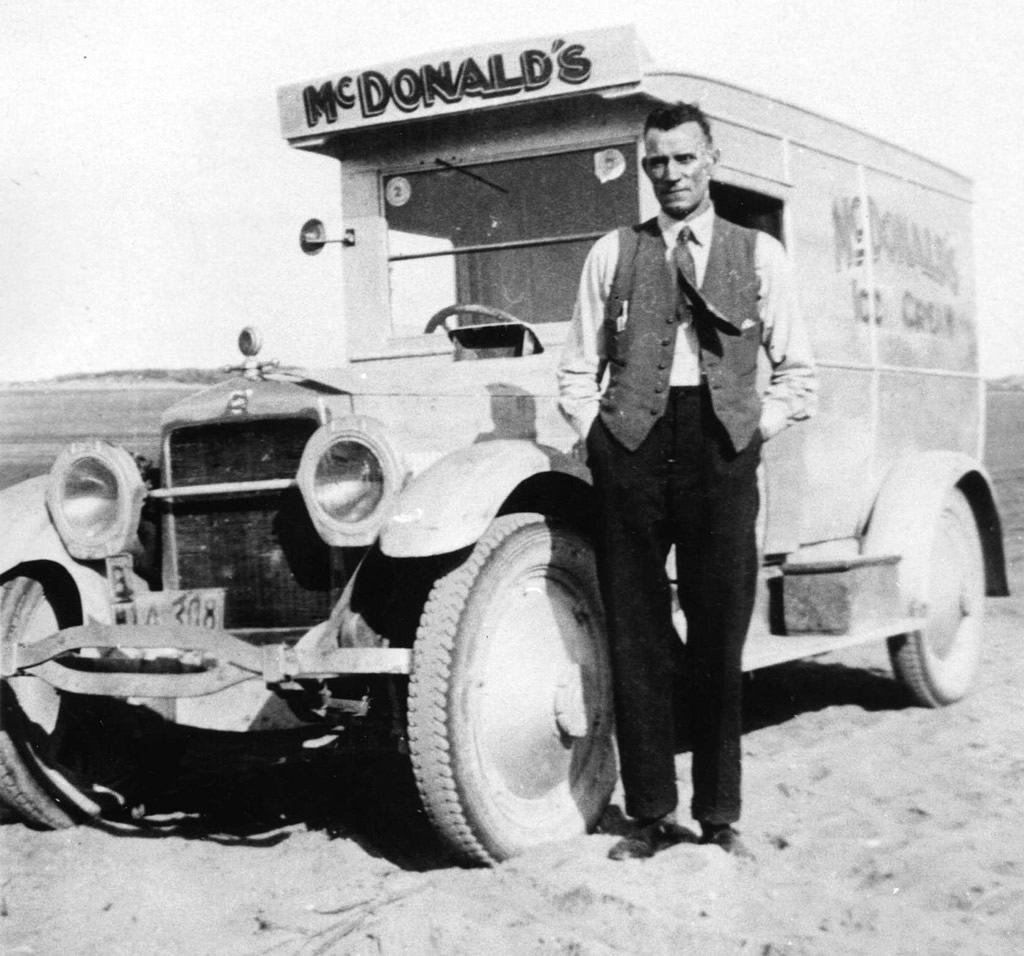
Curly Smith with McDonald's Ice Cream delivery van, Foxton
Beach, 1929.
- Foxton Historical Society: Kete Horowhenua
Ref. f1999.0825

McDonald's Famous Ice Cream advertisement, Evening Post,
25 February 1930.
Angus McDonald attended the inaugural annual conference of the NZ Ice
Cream Manufacturers' Association in March, 1928. McDonald's was one
of the first eight member companies.
Angus is said to have pioneered Neapolitan ice cream in New Zealand
- the triple-layered chocolate, vanilla and strawberry classic.
In December 1929 a new ice cream company was registered, A. K. McDonald
(Auckland), Ltd., with capital of £2800. Shareholders were Angus
McDonald, William Meek, and Nicola and Emily Astrella. The Astrella
family were Auckland's original ice cream manufacturers. We don't know
if this company ever produced ice cream, or if it was simply a vehicle
for investing in other businesses.
It is thought that Angus's move into the Auckland market was initially
by way of investment in an existing business, Polar Ice Cream Company,
which had a factory in Station St., Newmarket. Polar had the sole rights
to Eskimo Pie in Auckland and was being run by Dick Naylor, who had
sold Angus those first Frigidaire freezer cabinets. It appears that
Polar ran into difficulties and the New Polar Ice Cream Company was
established in September 1929 to take over Polar's operations.
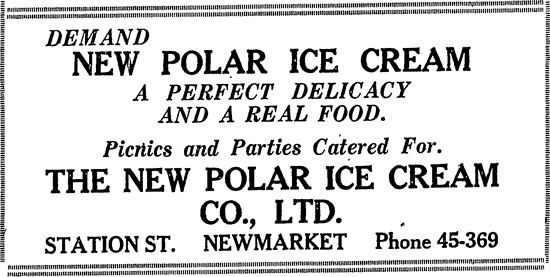
New Polar advertisement, Auckland Star, 12 December 1929.
Polar Bars. Ice Cream Cakes. Rainbow Blocks - layered orange, vanilla
and strawberry ice creams sandwiched between wafers. In May 1930
New Polar Ice Cream Company merged with Astrella Ice Cream Company,
and in July 1930 a further merger was announced between the New Polar
- Astrella and Robinson's ice cream companies, but this did not eventuate.
Robinson's was Auckland's largest manufacturer at the time.
In 1931 the McDonald's Hamilton operation moved into a new factory
in Bryce St. Advertising from that period, including signage on the
factory, shows the company was selling a novelty called a "Fro
Joy".
That year Angus's brother Stuart, who owned and ran tea rooms at 235
Cuba St. in Wellington, moved up to help run the Auckland operation.
First he trained with Angus at the Palmerston North factory, and then
took up the position of Manager at the New Polar plant in Newmarket,
Auckland. New Polar was still located at Station St. in January 1931
but appears to have moved to Teed St. some time that year.
Sadly, the Great Depression took its toll on the business - New Polar
was reported to be in liquidation by April 1931 and was taken over
by Peters Ice Cream (NZ) Ltd in 1932.
Angus did not get on with the new management and left shortly after
selling up; Stuart followed soon afterwards.
Stuart opened up a delicatessen and butchery business, `Nikau Delicatessen',
at 175 Karangahape Road, Newton in Auckland, but later turned it into
a "home cookery", selling amongst other treats, McDonald's
Ice Cream:
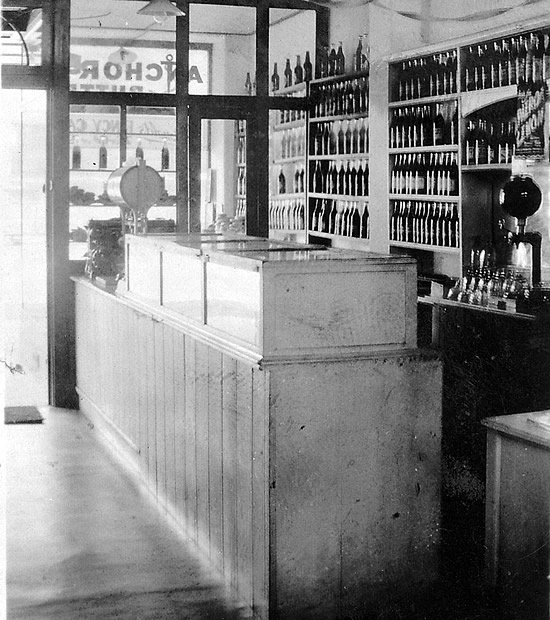
Stuart McDonald's home cookery, Karangahape Rd, 1930s, with
ice-packed,
insulated ice cream cabinet. Note sign at right, "Ask for Paeroa & Lemon" and
front
window signage, "Anchor Butter" and "McDonald's Fancy
Cakes".
- Raymond
McDonald.

Seated area in Stuart McDonald's home cookery, Karangahape
Rd, 1930s.
- Raymond
McDonald.
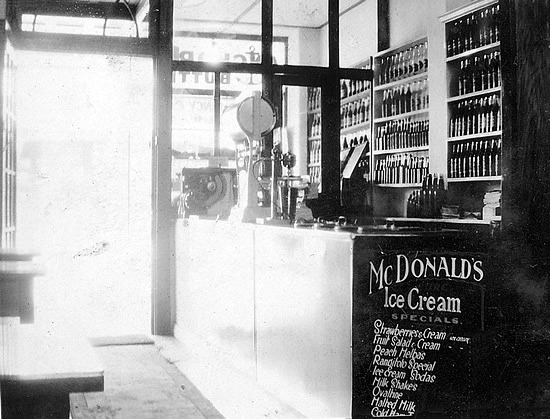
The Karangahape Rd home cookery, with electric (Frigidaire?)
freezer cabinet installed
- steel lids visible on top of the counter, and an electric milkshake
mixer next to the
scales.
- Raymond
McDonald.
Master baker Stuart and his son Lloyd sold bread, pastries, biscuits,
slices and cake, all made with real Anchor New Zealand butter. They
also served cold drinks - soft drinks, milkshakes, ice cream sodas,
malted milk, Ovaltine - and McDonald's ice cream sundaes - Strawberries & Cream,
Fruit Salad & Cream, Peach Melba and the legendary Rangitoto
Special.
The "Rangitoto Special" sundae was an institution around
Auckland milk bars through the 30s and 40s; three scoops of ice cream
(a larger one in the middle) topped with syrup, strawberries or glace
cherries, and a pink wafer biscuit on top.
Later Stuart opened a second shop in Queen St., next to the St James
Theatre. The business also developed a wholesale market delivering
cakes and pies to outlets in the surrounding suburbs. All of Stuart’s
five sons (Lloyd, Ralph, Alan, James, and Leslie) worked in the family
home cookery business.
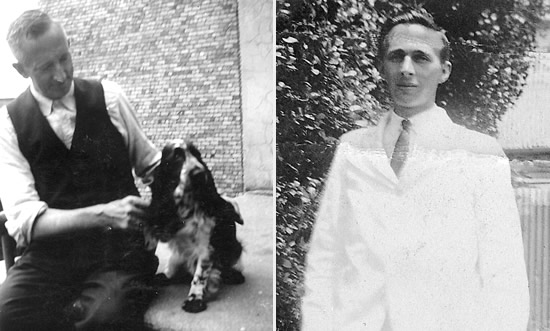
Stuart McDonald and his son Lloyd, both photos taken behind
their Karangahape Rd
home cookery.
- Raymond
McDonald.

Lloyd and his wife Nellie in the Queen St. shop.
- Raymond McDonald.
Meanwhile Angus was supplying his own McDonald's brand ice cream into
the Auckland market and had set up an Auckland office at 10 Quay
St.
Around 1935, he opened an Auckland ice cream factory in Kings Drive
(near the new Railway Station). R.W. McDonald became the manager, and
Leo Garvey and Pat Fay were involved in the Auckland operation.
At this point, with coverage of most of the North Island, McDonald's
would have been one of the largest ice cream companies in the country.

McDonald's second ice cream factory (centre), Bryce Street,
Hamilton, 1939.
- Ref: HCL_5162 (detail), Hamilton City Libraries
Heritage Collections.
Stuart McDonald died on 20 October 1939.
Angus Keith McDonald died in 1946, aged 53.
Ken Johnstone appears to have taken over management of the business.
Other names associated with McDonald's Hamilton were R.J. Tucker and
R.G.P. Brownless.

McDonald's Ice Cream (Auckland branch) refrigerated truck,
1951.
- NZ Ice Cream Assn. archives, Frostee
Digest.
In 1951, the company was represented at the annual Ice Cream Manufacturers
Conference held in Wellington by Ken Johnstone, A.R. Watkins, R.G.P.
Brownless and Jim Winstanley (ex-Frosty Jack).
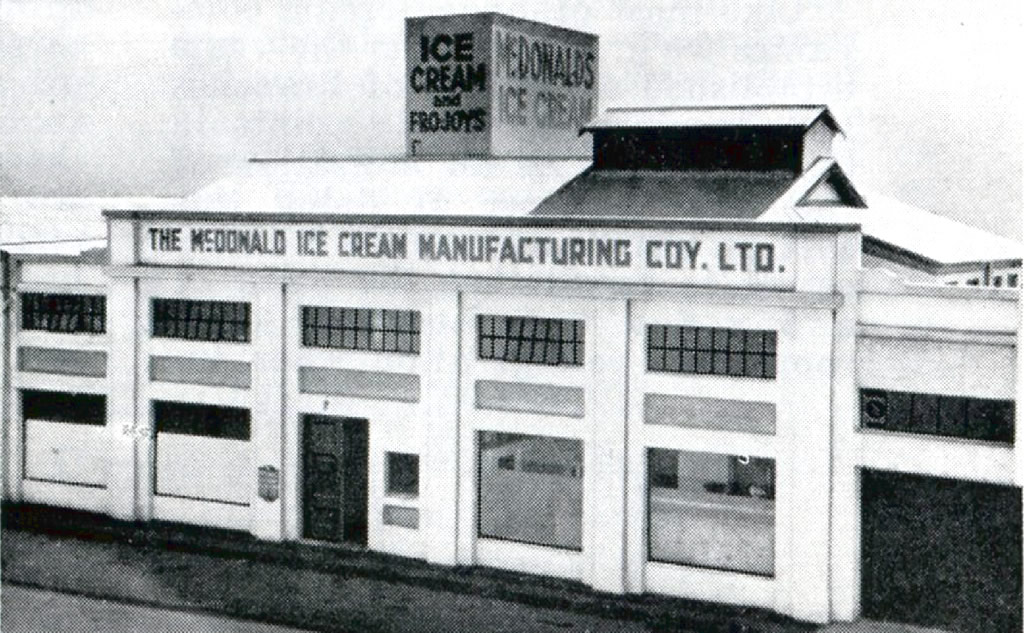
McDonald's Ice Cream Hamilton factory, Bryce St., 1950s.
- NZ Ice Cream Assn. archives, Frostee
Digest.
Stuart's son Ralph continued the McDonald family's entrepreneurial
food exploits, establishing the McDonald's Chips business, long before
the American fast food giant arrived in New Zealand, becoming an
institution at events and showgrounds around Auckland in the 50s
and 60s.
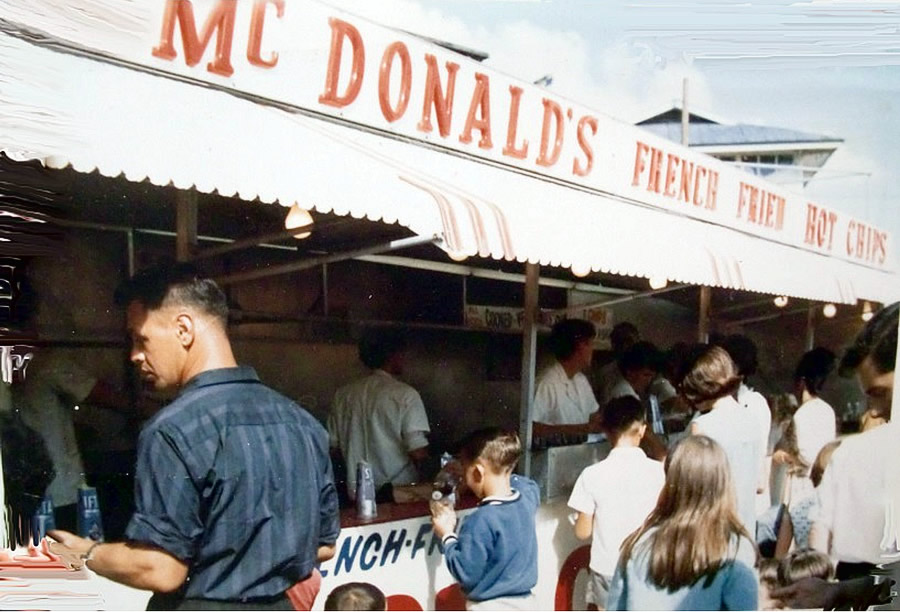
McDonald's French Fried Hot Chips, 1966.
- Carole Prentice.
In late 1958, the McDonald's Ice Cream Manufacturing Co. was taken
over by Tip Top (Auckland).
|